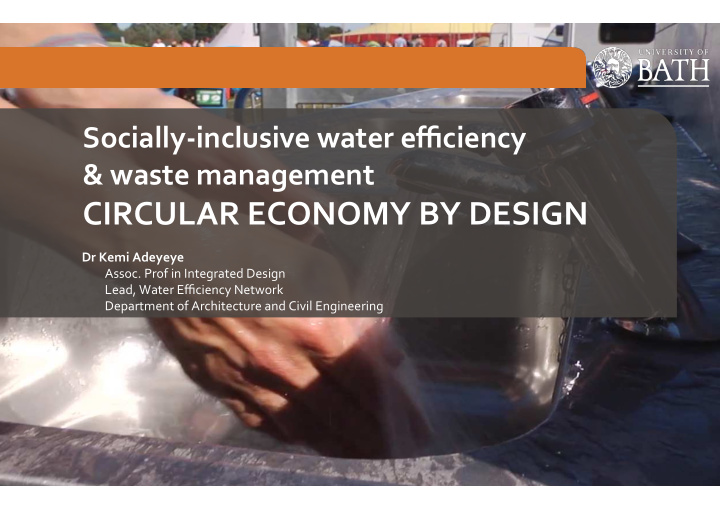



Socially-inclusive water efficiency & waste management CIRCULAR ECONOMY BY DESIGN Dr Kemi Adeyeye Assoc. Prof in Integrated Design Lead, Water Efficiency Network Department of Architecture and Civil Engineering
Research focus: • 5Ps: people, process, performance, policy, products Source: whconference.unc.edu • Socio-technical studies to mitigate environmental impact and change • Integrated design and solutions for resource efficiency and resilience (RE+R)
Global view Water is a vital human and natural resource It is also a scarce resource and this poses challenges for the 21st century and beyond Source: United Nations Environment Programme (UNEP). Online at: http://www.unep.org/dewa/vitalwater/ article141.html Market for water supply, sanitation and water efficiency estimated at US$ 253bn and is • expected to grow to US$ 658bn by 2020 Estimated investment of US$ 15bn per annum •
Water Efficiency & Waste recovery • Social-technical, multi-stakeholder studies • Process efficiency, optimisation • Project examples: service innovation in supply networks, resource efficiency in domestic and commercial sectors: e.g. laundrettes, hotels “Water efficiency is not just about conserving water Instead, an understanding of customer behaviour and need is realised such that water is used optimally and through behaviour, technology and infrastructure efficiency, waste is eliminated”. 1 Balnave, J., & Adeyeye, K. (2013). A comparative study of attitudes and preferences for water efficiency in homes. Journal of Water Supply: Research and Technology-Aqua, 62(8), 515-524.
Decentralised/ alternative water supply Alternative water supply systems and • solutions can help to save water, energy, and money They are an essential component of a • circular economy for water and can help to address social challenges too Examples of non-potable (not for • drinking) use include: • Agriculture and landscape irrigation Source: Waterscan • cooling water in building services and industrial applications Common technologies: • construction activities e.g. concrete rainwater recycling • mixing greywater reuse • seawater desalination and; • Domestic uses e.g. toilet flushing • integrated sustainable urban drainage • systems
Micro Scale Source: Window on America Centre in Dnipropetrovsk. Online at: http://woadnepr.blogspot.co.uk/2014/08/energy-evolution.html
Macro-meso scale Source: Thames Water Making demand-supply chain optimised and efficient reduces waste, without compromise to quality
Socially-inclusive waste minimisation and circular economy in Spain
Current work and Demand & Waste reduction circular economy Supply - Integrated social-environmental Service studies on: People-centred innovation - Integrated solutions for water- energy-(food?) - Service innovation – socially Natural and Product inclusive, optimised processes, built Resilience innovation environment reduced waste Efficiency Manufacturing, processes supply chain
Current work: Reducing Energy Dependency in Atlantic area Water Networks (REDAWN) - Distributing our Water Resources: Utilising Integrated, Smart and low-Carbon Energy (DWR UISCE) (Source: Ferras, D. Trinity College Dublin) nvestigators: Action Renewables, Northern Ireland (Lead); Trinity College Dublin; Northern Ireland Water; Watef Network- University of Bath; Università degli Studi di Napoli FEDERICO II Italy; Empresa De Electricidade da Madeira S.A. Portugal; EDA RENOVÁVEIS S.A. Portugal; Instituto Superior Tecnico Portugal; Hidropower Ltd ortugal; RENOVA S.A. Portugal; Parceria Portuguesa para a Água Portugal; Asociación FERAGUA de Comunidades de Regantes de Andalucía, Spain; Universidad de órdoba, Spain; Fundacion Asturiana de la Energia, Spain.
Current work: Healthy Housing for Displaced People
Current projects: Smart systems, smart cities Information and communication systems • Smart tools • Smart microgrids and micronets • Localised Integrated Optimised Sustainable Resilient Efficient
Resilience: Avoiding the boom and bust cycle Source: Consultamcy.uk Lack of planning can lead to wasteful response, and breakdown of good practise. Resilience should be part of a circular economy
Main findings from previous research Resources/materials/products are not just • commodities, they have social (livelihood, quality of life) and environmental impact People should be at the core of circular economy policy • and practices Everything is connected –so opportunities for: • • Value creation – local, regional, global • Resource efficiency and reduced waste (materials, processes etc.) • Information is key • Integration/Joined up thinking helps to identify opportunities for value creation and waste minimisation
Collaboration • Circular economy through water efficiency, reuse and recycling (WASH) • Circular economy (for resilience) in (informal) urban settlements • Integrated water-energy cradle to grave solutions • Energy recovery and reuse measures especially from water processes • Combined value creation for waste minimisation and resilience • Participatory, co-created design and implementation of solutions (collaborative value creation) • Improving adaptive capacity (e.g. through education and training) for better use practices and waste reduction in processes
THANK YOU Email: k.Adeyeye@bath.ac.uk Website: http://www.bath.ac.uk/ace/people/adeyeye/ Publications: https://www.researchgate.net/profile/Kemi_Adeyeye/publications
Recommend
More recommend